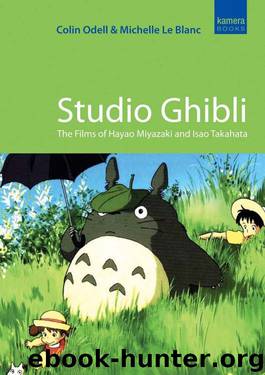Studio Ghibli: The Films of Hayao Miyazaki and Isao Takahata by Michelle Le Blanc & Colin Odell

Author:Michelle Le Blanc & Colin Odell [Blanc, Michelle Le]
Language: eng
Format: epub
ISBN: 9781842434925
Publisher: Oldcastle Books
Published: 2009-08-31T18:30:00+00:00
Only Yesterday (Omohide poro poro) (1991)
Written and directed by: Takahata Isao
Produced by: Miyazaki Hayao and Suzuki Toshio
Okajima Taeko, a hard-working Tōkyō office lady, has decided to take a break from the pressures of city life. Her aim is simple: to visit a rural heaven that she can call home, if only for a week or so. As luck would have it, her sister’s husband’s family happens to own a farm in Yamagata so Taeko leaps at the opportunity of spending some time working in the fields. But somehow Taeko is constantly reminded of her life growing up as a girl in Tōkyō and begins to feel that her trip is awakening memories of a part of her life she cannot fully reconcile. Met at the station by Toshio, a relative of the person she was expecting to meet, she is driven to the little mountain farm, eager to get started. This turns out to be quite fortuitous for part of the farm’s work is picking and processing safflower, a task suited to the early morning. The work is hard and relentless but its physicality, the natural open air and the unpretentious company of her co-workers make Taeko feel happy for the first time in many years. Observing this brief transformation is her early self, the young teenage girl whose life, loves and heartaches have created the woman she is today. But will the break lead to long-term contentment for Taeko, or will this be a fleeting glimpse of happiness preceding a return to the daily drudgery of office life? For, as an unmarried lady of 27, her chances of attaining some sort of domestic stability are slipping away.
In contrast to the more fantastical films of Studio Ghibli, Only Yesterday is a contemporary drama. On the surface this appears strange, as animation is a time-consuming and expensive way of realising a film that, for the most part, could have been shot with live actors. However, there are a number of reasons why Only Yesterday is more ideally suited to anime, not least of which is the total control that animation gives its creators. It is set in two time frames – the early 1980s as Japan was approaching the peak of its economic might, and 1966 when urbanisation was developing rapidly. Realising both these time periods would have been expensive in a live-action film and the way Only Yesterday merges the past and present could have caused logistical difficulties. For the most part it is stylised, a realistic sense of the film’s ‘now’ contrasting with the less authentic ‘realism’ of 1966 without resorting to flashback clichés.
Takahata’s script for Only Yesterday was derived from Okamoto Hotaru and Tone Yuko’s nostalgic josei manga (comics designed for women), which feature vignettes from the life of an 11-year-old girl, Taeko, in the 1960s. The first volume was published in 1990 and is part of a long-running genre of ‘little snippets of life’ manga made famous by such Japanese institutions as Sazae-san. Rather like My Neighbours
Download
This site does not store any files on its server. We only index and link to content provided by other sites. Please contact the content providers to delete copyright contents if any and email us, we'll remove relevant links or contents immediately.
Shoot Sexy by Ryan Armbrust(17659)
Portrait Mastery in Black & White: Learn the Signature Style of a Legendary Photographer by Tim Kelly(16953)
Adobe Camera Raw For Digital Photographers Only by Rob Sheppard(16906)
Photographically Speaking: A Deeper Look at Creating Stronger Images (Eva Spring's Library) by David duChemin(16623)
Bombshells: Glamour Girls of a Lifetime by Sullivan Steve(13977)
Art Nude Photography Explained: How to Photograph and Understand Great Art Nude Images by Simon Walden(12975)
Perfect Rhythm by Jae(5326)
Pillow Thoughts by Courtney Peppernell(4211)
The Book of Joy by Dalai Lama(3903)
Good by S. Walden(3488)
The Pixar Touch by David A. Price(3364)
A Dictionary of Sociology by Unknown(3031)
Fantastic Beasts: The Crimes of Grindelwald by J. K. Rowling(2995)
Humans of New York by Brandon Stanton(2835)
Stacked Decks by The Rotenberg Collection(2812)
Read This If You Want to Take Great Photographs by Carroll Henry(2664)
On Photography by Susan Sontag(2576)
Insomniac City by Bill Hayes(2499)
Photographic Guide to the Birds of Indonesia by Strange Morten;(2490)
